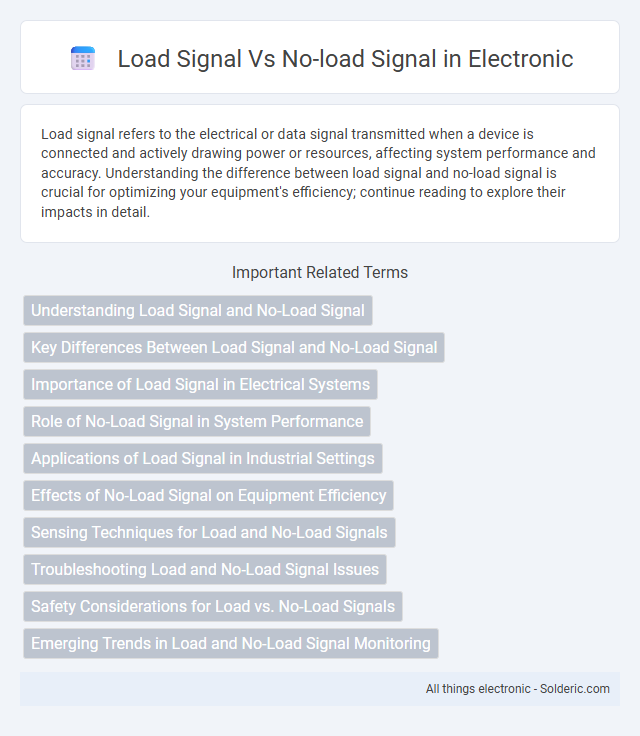Load signal refers to the electrical or data signal transmitted when a device is connected and actively drawing power or resources, affecting system performance and accuracy. Understanding the difference between load signal and no-load signal is crucial for optimizing your equipment's efficiency; continue reading to explore their impacts in detail.
Comparison Table
| Feature | Load Signal | No-Load Signal |
|---|---|---|
| Definition | Signal transmitted under operational load conditions | Signal transmitted without any operational load |
| Signal Strength | Typically lower due to load impact | Higher, unaffected by load resistance |
| Usage | Real-time monitoring and actual operation analysis | System calibration and baseline measurement |
| Energy Consumption | Higher due to active load | Minimal, no power drawn by load |
| Signal Distortion | Possible due to load-induced noise | Minimal distortion, ideal conditions |
| Application Example | Electrical circuit under full operation | Open-circuit testing or no current flow |
Understanding Load Signal and No-Load Signal
Load signal refers to the electrical signal received when a device or circuit is actively connected to a power source, causing current flow and indicating operational status. No-load signal occurs when the circuit is powered but no current flows due to the absence of a connected load, reflecting standby or idle condition. Understanding the difference between load signal and no-load signal is essential for diagnosing circuit performance and ensuring your equipment functions efficiently under varying power conditions.
Key Differences Between Load Signal and No-Load Signal
Load signal represents an input or output carrying current under operating conditions, indicating active power flow in electrical systems or devices. No-load signal occurs when the system or device is powered but not delivering or consuming current, reflecting idle or standby states. Key differences include the presence of current flow, power consumption status, and implications for system performance and diagnostics.
Importance of Load Signal in Electrical Systems
Load signals in electrical systems are crucial for monitoring current flow and ensuring system stability by reflecting real-time demand on the circuit. Accurate load signal detection supports efficient energy management, preventing overloads and minimizing power losses. Understanding your load signals enables proactive system adjustments, enhancing overall safety and performance.
Role of No-Load Signal in System Performance
No-load signals serve as crucial baselines in system performance by indicating the system's state without external loads, enabling accurate calibration and fault detection. These signals help in distinguishing normal operational conditions from anomalies caused by external stresses, improving diagnostic precision. Understanding your system's no-load signal ensures more reliable performance monitoring and maintenance scheduling.
Applications of Load Signal in Industrial Settings
Load signals are crucial in industrial settings for monitoring and controlling machinery performance, ensuring optimal operation under varying load conditions. They enable predictive maintenance by detecting abnormal load patterns, reducing downtime and increasing equipment lifespan. Your industrial processes benefit from precise load signal data to enhance safety, efficiency, and real-time decision-making.
Effects of No-Load Signal on Equipment Efficiency
No-load signals cause electrical equipment to draw power without performing useful work, leading to energy wastage and reduced overall system efficiency. These signals increase reactive power flow, causing higher losses in transformers and generators, and elevate operating costs. Minimizing no-load conditions through proper signal management enhances equipment longevity and operational efficiency.
Sensing Techniques for Load and No-Load Signals
Load and no-load signals are critical in sensing techniques for monitoring electrical systems, where load signals indicate active power consumption while no-load signals reflect the baseline or idle state. Techniques such as current transformers (CTs), Hall effect sensors, and Rogowski coils effectively detect load signals by measuring current flow, whereas voltage sensors or capacitive coupling methods are used to identify no-load conditions by sensing voltage presence without current. Your choice of sensing technique depends on the accuracy required and the system's operational characteristics to ensure precise load management and energy optimization.
Troubleshooting Load and No-Load Signal Issues
Troubleshooting load and no-load signal issues involves verifying signal integrity by checking voltage levels and continuity in both loaded and unloaded circuits. Use diagnostic tools like multimeters and oscilloscopes to measure signal strength, ensuring that load signals maintain expected current flow while no-load signals show appropriate open-circuit conditions. Identifying problems such as signal attenuation, interference, or faulty wiring enables targeted repairs and optimal system performance.
Safety Considerations for Load vs. No-Load Signals
Load signals carry electrical current, presenting higher risks such as electric shock and equipment damage, requiring strict insulation and protective measures to ensure safety. No-load signals typically have lower voltage and current, reducing the risk but still necessitating proper handling to avoid false readings and potential hazards. Ensuring your system distinguishes clearly between load and no-load signals enhances operational safety and prevents unintended electrical faults.
Emerging Trends in Load and No-Load Signal Monitoring
Emerging trends in load and no-load signal monitoring emphasize the integration of AI-driven analytics and IoT-enabled sensors, enhancing real-time accuracy and predictive maintenance capabilities. Advanced machine learning models now distinguish subtle variations between load and no-load signals, optimizing energy consumption and reducing operational costs. Furthermore, edge computing facilitates faster processing of signal data, enabling immediate response to load fluctuations and minimizing downtime in industrial applications.
load signal vs no-load signal Infographic

 solderic.com
solderic.com